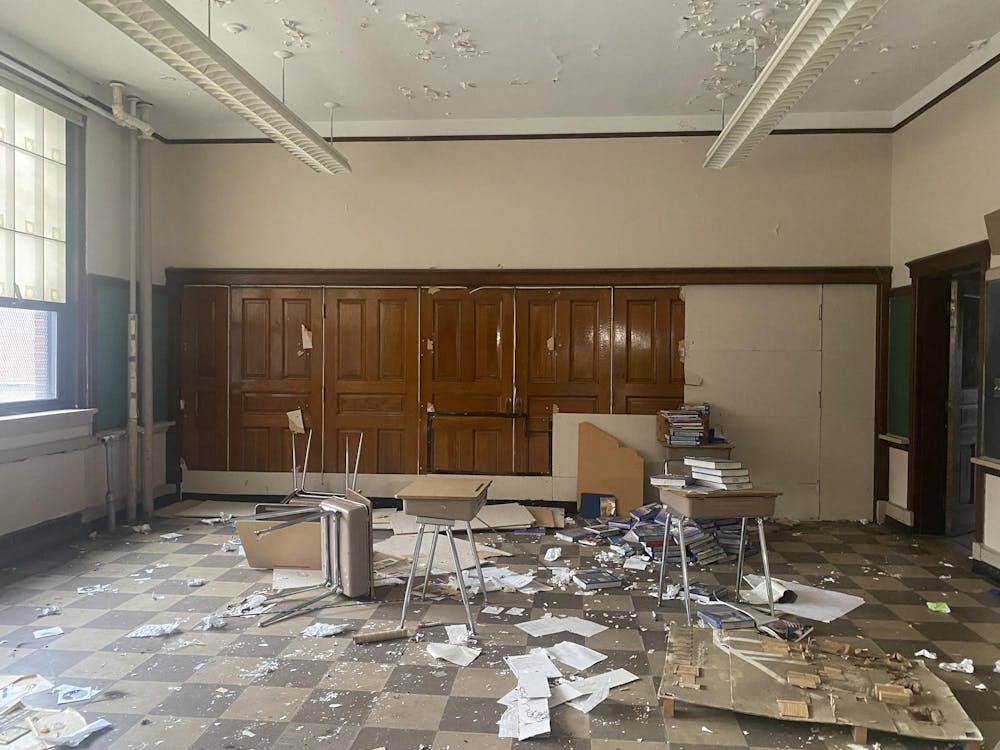Woonsocket Middle School closed its doors 14 years ago. Today, in the largest abandoned school in New England, glass crunches underfoot, water damage warps the floors in the basement and the ceiling tiles flake with age.
Now, organizers hope to breathe new life into the abandoned building, which clocks in at over 200,000 square feet, by transforming the structure into around 150 apartments.
Woonsocket Middle School is just one of various adaptive reuse projects in Rhode Island that recycle buildings, such as storage space and office buildings, for purposes different from what their original architects imagined.
This year, Rhode Island state House Speaker K. Joseph Shekarchi introduced a sweeping package of housing bills, 13 of which are set to go into effect next year. One of the bills allows for adaptive reuse in local zoning ordinances and makes the process easier in the hopes of increasing the state’s affordable housing stock. While Woonsocket Middle School’s reuse plans began before the bill went into effect, it might serve as an example of one key solution that will address the state’s housing crisis.
Built in 1914, Woonsocket Middle School was abandoned in December 2009. Boston-based developer The Goldman Group purchased the property for $1 million in 2022 and hired David Sisson Architecture to redesign the building into market-rate apartments.
“Large buildings that are very expensive to reconfigure for any use are often in rough condition and have a challenge at the local approval level,” said David Sisson, principal architect at David Sisson Architecture and the architect for the Woonsocket Middle School redevelopment. “Sometimes the zoning is not favorable.”
With the new law not in effect, Woonsocket’s City Council created a "spot zone" making an exception for the building’s zoning allowing it to be transformed into apartments, Sisson said.
“Getting a use variance is very difficult,” Sisson said. “You basically have to prove that there’s no other beneficial use of the property than what you’re suggesting.”
The new law only allows developers to reuse buildings if the building dedicates a certain portion of units to low- and moderate-income housing, Sisson said.
Renovating an old building like the middle school comes with a host of challenges, Sisson said. While developers purchased the building for $1 million, “the actual conversion is going to be tens of millions,” he noted. “It is always a challenge to get somebody to fund that.”
Woonsocket Middle School is listed on the National Register of Historic Places. This status both opens up funding opportunities through tax credits and creates limitations due to the register’s requirements.
For example, the pre-existing doors in the middle school may not measure up to apartment buildings’ minimum fire resistance rating. The challenge is for the team to design a door that has a fire rating but still looks very similar to the original. By doing this for every door, the price tag grows.
Many other issues need to be addressed: “The floor has asbestos in it, guaranteed. The paint has lead in it, guaranteed,” Sisson said. “We have to deal with putting in modern electrical systems, modern plumbing systems, modern heating and air conditioning systems. Those are just some of the challenges we deal with.”
“The goal is that when this is done, it should look like a school,” Sisson said. “You should feel like you’re living in a school. That’s the flavor we hope to get.”
Even if Woonsocket Middle School successfully transforms into apartments, it’s one building in a larger crisis throughout the state. And according to Shekarchi, Rhode Island’s housing crisis is part of a national issue: “The thing that has been proven across the country is that you have to increase the housing stock,” he said. “If there’s more housing available, the price is stabilized, the prices come down and then people are able to afford clean, safe housing.”
Brenda Clement, director of HousingWorks RI, explained that most funding to build affordable housing comes from the federal level, with less coming from the state. Decisions on what is built and how the construction process will work are left up to local officials.
The laws aim to “unclog the cogs that exist at the local level with local zoning ordinances, local regulations and trying to streamline the process a little bit,” Clement said.
“There’s still a lot of changes that have to happen at the local level,” Clement said. The bills try “to provide a pathway and an incentive and more importantly, some support for technical assistance and support for communities to change those local regulations.”
According to Shekarchi, adaptive reuse is attractive to developers because the buildings’ foundational infrastructure, like elevators and pipes, already exists.
“It makes sense from a whole lot of perspectives to repurpose and reuse existing buildings rather than building out on green fields … particularly when we look at our climate change goals,” Clement said.
While the bill may have made it easier to get the go-ahead for adaptive reuse projects, “there’s still a lot of checks and balances,” Shekarchi noted. “These projects are not going to be just overnight turned into housing, but nevertheless, it will be a lot easier for a developer who looks at it.”
“We’ve been underproducing since the mid-1980s,” Clement said. “It’s really exciting for me to finally see us talking about how do we actually do this and then, more importantly, (getting) some resources to actually do it.’
“A lot of it is really new,” Clement said, referring to the new housing bills. “It’s changing the status quo, and lots of people don’t like change.”
“It’s new, it’s significant and there’s always pushback,” Shekarchi said. “We need for everybody to think out of the box.”
“This is a crisis that we need all hands on deck,” he added. “We’re going to need everyone’s help.”





